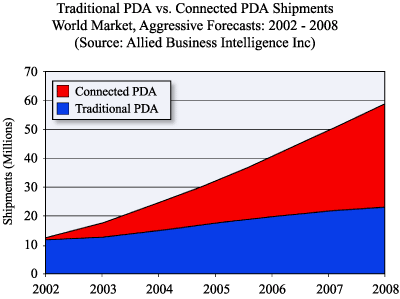Report: Connected PDAs to outnumber traditional PDAs by 2006
Sep 9, 2003 — by LinuxDevices Staff — from the LinuxDevices Archive — viewsAlthough low replacement rates and slow shipments have been paralyzing the PDA industry for some time, the emergence of converged devices — such as the “Connected PDA” — may provide the relief the industry has been seeking, reports analyst firm Allied Business Intelligence (ABI). According to ABI, while Connected PDAs have not gained much traction due, in part, to limitations of existing form factors, new Connected PDA products such as the soon-to-be-launched Treo 600 will change this.

Connected PDAs and Smartphones differ in that Connected PDAs are converged devices with a PDA-based standardized OS like that of Palm or Microsoft Mobile Software for Pocket PCs. Smartphones, on the other hand, are more like standard cellular handsets and employ a related OS. “Connected PDAs will represent over 50% of the total PDA market by 2006,” notes Kenil Vora, ABI analyst, “unlike Smartphones, which will continue to represent only a small portion of the overall handset market.”
ABI's newest report, Personal Digital Assistants: A Strategic Analysis of Connected and Unconnected PDAs, examines the strategies adopted by major PDA OEMs and analyzes revenue growth expected in the Connected PDA market. The report finds that the overall PDA market is expected to grow to $10 billion by 2008 with a major portion derived from Connected PDAs.
Despite other research claiming an overall decline in the traditional PDA market, ABI research contends that this market will actually experience modest growth of 8% CAAG through 2008. ABI's contrarian views stem from different form factors and emerging technology applications for traditional PDAs such as telematics, satellite location, barcode scanning, RFID tracking and digital photography.
Operating Systems will be a major factor for the Connected PDA market as well. Whereas PalmSource is focused solely on the Connected PDA market, Linux and Microsoft also compete in the Smartphone segment with different variants of their OS. In this segment, Symbian's OS dominates the market. “Symbian will continue to garner individual customers for its rather user-friendly and 'sticky' OS,” continues Vora, “while Microsoft's Windows Mobile Software for Smartphones will serve to frenzy the enterprise user.”
A second report by ABI, Wireless Handset Software: The Evolution of OS and Middleware Solutions and Their Impact on Next Generation Wireless Devices, examines the strategies adopted by major wireless OS and middleware providers and includes information and projections on various shipments and license fees.
This article was originally published on LinuxDevices.com and has been donated to the open source community by QuinStreet Inc. Please visit LinuxToday.com for up-to-date news and articles about Linux and open source.